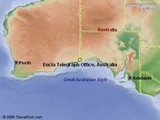Telegraphenleitungen von Nord nach Süd, von West nach Ost
Die zweite Großtat: Der East-West-Telegraph
James C. Fleming - Vom Sträfling zum Oberaufseher

![]() Fleming war erst wenige Jahre zuvor als Sträfling ins Land gekommen, hatte dann aber schon nach zwölf Monaten sein ticket of leave erhalten, die Begnadigung. Fleming schlug zunächst eine Route vor, die unmittelbar der Küste folgte - was den Vorteil habe, daß man entlang weiter Strecken Material und Nachschub anlanden könne (ein Irrtum, wie sich später zeigte). Aber rasch erwies sich, dass gerade die Nähe zum Ozean das Projekt zum Scheitern brachte. In der salzhältigen Luft korrodierte die Leitung; die Isolatoren verkrusteten sich mit Salz, was ebenso zu Erdschlüssen führte wie die hohe Luftfeuchtigkeit bei Dunst, Nebel und Regen. Die bessere Leitfähigkeit des Kupferdrahts über staubtrockenem Terrain gab den Ausschlag für den bereits 1872 gefassten Beschluß, die schwierigere Route weiter landeinwärts zu wählen.
Fleming war erst wenige Jahre zuvor als Sträfling ins Land gekommen, hatte dann aber schon nach zwölf Monaten sein ticket of leave erhalten, die Begnadigung. Fleming schlug zunächst eine Route vor, die unmittelbar der Küste folgte - was den Vorteil habe, daß man entlang weiter Strecken Material und Nachschub anlanden könne (ein Irrtum, wie sich später zeigte). Aber rasch erwies sich, dass gerade die Nähe zum Ozean das Projekt zum Scheitern brachte. In der salzhältigen Luft korrodierte die Leitung; die Isolatoren verkrusteten sich mit Salz, was ebenso zu Erdschlüssen führte wie die hohe Luftfeuchtigkeit bei Dunst, Nebel und Regen. Die bessere Leitfähigkeit des Kupferdrahts über staubtrockenem Terrain gab den Ausschlag für den bereits 1872 gefassten Beschluß, die schwierigere Route weiter landeinwärts zu wählen.
Der Baubeginn verzögerte sich bis April 1875 immer wieder; erst dann war die Finanzierung gesichert. Der knappe Budgetrahmen gestattete keine Erkundigungen vorab - was schwer wiegende Folgen hatte, denn bald gelangte man auf abweisendes, bizarr zerklüftetes Terrain. Als schließlich die Ebene erreicht war, Nullarbor Plain, kam der Nachschub fast völlig zum Erliegen, konnte die Versorgung der Arbeiter nicht mehr gewährleistet werden. Hier erstreckte sich von Horizont zu Horizont glühendheiße Wüste; wenige Kilometer weiter, an der Küste der Großen Australischen Bucht, zog sich der längste ungebrochene Steilabfall der ganzen Welt hin, hundert Meter hohe Klippen. Das bedeutete, dass die schweren Masten von Schiffen ausgesetzt werden mussten, ans Ufer trieben und dort mit von Pferden betriebenen Winden hochgehievt wurden, ehe man sie auf schwankenden Gefährten gemeinsam mit Nahrung und Wasser zur Baustelle schaffen konnte. Die Aborigines, die beim "Overland Telegraph" immer wieder um ihr Land gekämpft hatten, sahen tatenlos und eher amüsiert zu: Die dummen weißen Eindringlinge bauten einen vier Meter hohen Weidezaun, unter dem die Schafe - gäbe es sie denn hier überhaupt - bequem durchlaufen konnten!
Als sich die beiden Leitungen allmählich näherten, wurde der provisorische Betrieb aufgenommen. Die Lücke zwischen den Endpunkten in Western und South Australia schlossen berittene Boten: "Morse by horse!" lauteten die Schlagzeilen.
Die gesamte Leitung, 1.900km zwischen Port Augusta und Eucla, 1.204km zwischen Albany und Eucla, wurde am 8. Dezember 1877 ihrer Bestimmung übergeben. Jetzt war die "Western Australian Section" in Eucla mit der "Southern Australian Section" verknüpft und an die "Overland Telegraph Line" angebunden. Nun dauerte die Übermittlung einer Nachricht von Perth, "der am meisten von der Außenwelt isolierten Großstadt des Planeten" nach London nur noch 24 Stunden!
James C. Fleming actually arrived in Australia a few years earlier as a convict but was soon granted a form of parole called a 'ticket of leave' a year after arrival. He advised the adoption of a coast route because materials and supplies could be landed at convenient distances. However, the proximity to the ocean proved to be this route's eventual demise. The salt-impregnated air corroded the line and encrusted the insulators with crystals which provided a path to earth. Dampness due to sea mists coming off the ocean also created a path to earth. Better conductivity along copper wires through perfectly dry country was the reason why the inland route was chosen in 1872 in favour of the old coastal path. Construction of the Line began in April 1875 with no preliminary survey being permitted. It was back-breaking work. Many kilometres were through extremely dense, rugged terrain and when eventually the Nullarbor Plain was reached, great difficulties arose in supplying the work parties. The 100-metre high cliffs of the Great Australian Bight are the longest stretch of unbroken cliffs in the world. This meant that the heavy jarrah poles to support the telegraph line had to be brought to the Bight by sea, floated ashore and then winched up the cliffs by teams of horses. Water and food, almost non-existent in that arid land, had to be carted in.
Nullarbor Plain:
Extending from the SW part of South Australia for about 725km E-W into Western Australia, and from the Great Australian Bight N for about 400km, covering 270.000km2. Named by E. Alfred Delisser in 1866, derived from the Latin nullus arbor, meaning "no tree". Called a plain, though in fact it is a limestone plateau with cliffs bordering the Bight shoreline. It is a region of extremely low rainfall (254mm annually in Eucla). Even today there are only scattered sheep stations on the margins of the plain. One section of the transcontinental railway (160km inland) across the plains extends for 478km in a straight route and is claimed as the longest stretch of straight railway line in the world.)
"Telegrams by horse and Morse"
The humour of the situation was not lost on tribal Aborigines who thought the white men were extremely silly stringing what they thought was a four-metre high fence through pastoral country. Quite obviously, the sheep would walk under the wire and escape! As the telegraph line neared its South Australian counterpart, telegrams were forwarded by horse express between field operators at the head of each line - telegrams by horse and Morse! The first East-West Telegraph line comprising of 1900 kms of single iron wire linking Perth to Adelaide via Albany, Eucla and Port Augusta was finally completed on December 8th 1877 Via this Inter-Colonial Telegraph Line, a north to south line through the centre of Australia and a submarine cable link back to Europe, Western Australia was for the first time in touch with the outside world. Messages that once took six months by ship could now be relayed between Britain and WA within 24 hours. It existed for just one reason - to allow the planet's most isolated capital city - Perth, get in touch with the outside world.
Chronology
1869. A 12-mile wire was hoisted on poles to Fremantle and opened on 21st June 1869 being 15 years after the first line in Australia was opened in Victoria.
Text of first telegram transmitted: "TO THE CHAIRMAN OF THE FREMANTLE TOWN TRUST. HIS EXCELLENCY COLONEL BRUCE HEARTILY CONGRATULATES THE INHABITANTS OF FREMANTLE ON THE ANNIHILATION OF DISTANCE BETWEEN THE PORT AND THE CAPITAL AND HE REQUESTS THAT THIS THE FIRST MESSAGE MAY BE PUBLICLY KNOWN. - GOVERNMENT HOUSE 21ST JUNE 1869."
1870. May. The Legislative Council passed a resolution authorising the construction of telegraph lines which would connect the towns of Albany, Bunbury, York and Newcastle (Toodyay) with Perth, and the Electro-Magnetic Telegraph Company was formed to construct those lines.
Initially telegraphs in WA were privately owned. The Western Australian Post and Telegraph Department, who had been operating the lines since 1871 despite not owning them, became sole owners and operators of the colony's telegraph system on 1st January 1873. Stations then in service were Perth, Fremantle, Guildford, Toodyay, Northam, York, Pinjarra, Bunbury and Albany.
1872. 28th December. Connection of line Perth - Albany.
More telegraphists were needed as the lines extended. The resourceful superintendent overcame this problem by training new operators as he went. With manpower scarce, many of the first telegraphists were young ladies.
1881. Lines had reached not only Eucla in the south-east, but also Northampton in the north, together with Beverley and Busselton in the south. Also in that year, plans were made to extend the line beyond Northampton to Roebourne.
1884. The main telegraph line between Perth and Wyndham is perhaps the longest direct line in the Commonwealth being about 2000 miles long.
It was worked duplex from Perth - Broome and extended on a simplex line to Wyndham with repeaters at Mullewa, Marble Bar and Broome.
The Darwin-Adelaide line was 1800 miles long.
1886. Perth-Fremantle line goes duplex-working.
1889. A submarine cable was landed at Broome which made WA independent of the Darwin-Adelaide line with its cables to Java laid in the 1870s.
1890's. The telegraphist's dream come true. No more pen and ink. The typewriter was introduced.
1894. Perth-Coolgardie line opened to cater for the multitude of messages from the WA goldfields.
1896. Second wire added to the Perth-Adelaide line.
1900. The PostMaster-General Richard Scholl reported that the total number of Telegraph Stations opened in Western Australia had reached 161.
The basic Morse system was used initially in simplex operation, a single message in one direction at a time. But technology enabled greater use of the one wire by engineering a number of electrical circuits along the single path. This line then linked up with a submarine telegraph cable laid between Darwin and Java on 21st October 1872, which was connected with the extensive British telegraph network, so providing Australia with its first telecommunications link with the rest of the world. The building of the Overland Telegraph Line had an unintended consequence. Western Australia went from being the first colony to receive the news from Europe to the last: Her only contact with the outside world was still by mail - up to six months delay in getting news from England by sailing ship and as many weeks from the Australian eastern colonies. Annoyed by colonial apathy, Perth newspaper proprietor Edmund Stirling offered to build a telegraph line between Perth and Fremantle if the government would supply and erect the poles. So the West Australian government agreed to build a telegraph line from Albany to Eucla to meet a South Australian line at the border, further linking with Adelaide and the Overland Telegraph line. This was granted under the supervision of a conditional release ex-convict Scot, James Coates Fleming who had been transported to Australia in 1864 for defrauding fellow Glaswegian tea merchants. The first pole was placed in position at a spot near the foot of the Perth jetty by the Colonial Secretary, the Honorable Fred Barlee. The Eucla Telegraph Line was later termed the Inter-Colonial Telegraph Line, or the East-West Telegraph.

